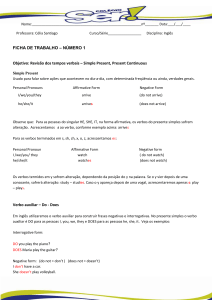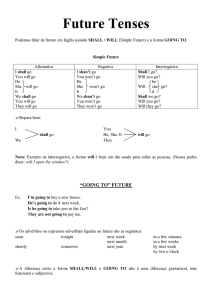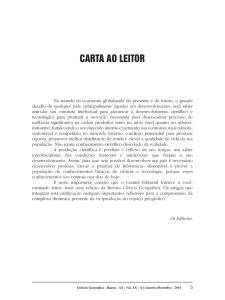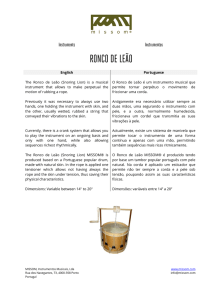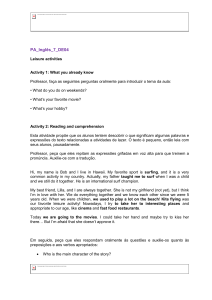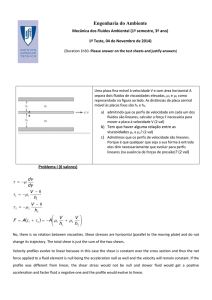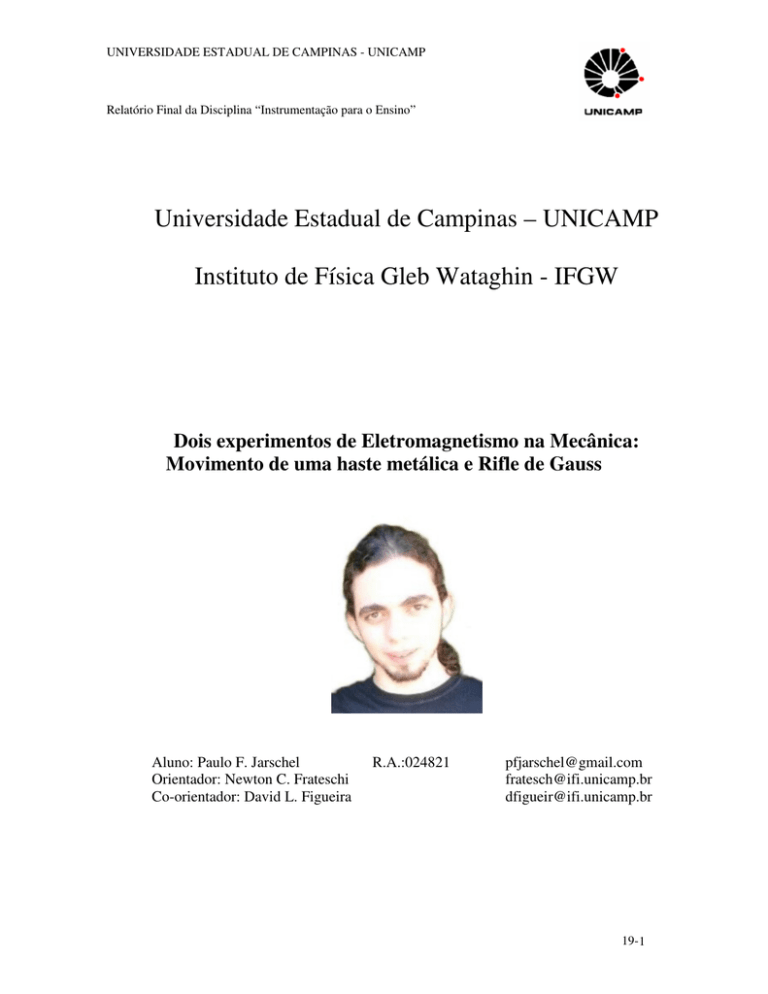
UNIVERSIDADE ESTADUAL DE CAMPINAS - UNICAMP
Relatório Final da Disciplina “Instrumentação para o Ensino”
Universidade Estadual de Campinas – UNICAMP
Instituto de Física Gleb Wataghin - IFGW
Dois experimentos de Eletromagnetismo na Mecânica:
Movimento de uma haste metálica e Rifle de Gauss
Aluno: Paulo F. Jarschel
Orientador: Newton C. Frateschi
Co-orientador: David L. Figueira
R.A.:024821
[email protected]
[email protected]
[email protected]
19-1
UNIVERSIDADE ESTADUAL DE CAMPINAS - UNICAMP
Relatório Final da Disciplina “Instrumentação para o Ensino”
Relatório Final
1)
Resumo:
Através de dois experimentos relativamente simples, é possível mostrar ao público
como podemos aplicar o eletromagnetismo na mecânica, ou seja, como podemos gerar
movimento utilizando, por exemplo, imãs e fontes de energia elétrica.
Estes dois experimentos são descritos brevemente abaixo:
1.1
Movimento de uma haste metálica:
Neste primeiro experimento, observa-se como se pode utilizar energia elétrica, na
forma de corrente, para fazer com que um pequeno objeto se mova.
Duas tiras de papel alumínio são coladas em um suporte isolante, como um pedaço
de papelão ou madeira. Estas tiras serão as trilhas que farão com que o pequeno objeto
metálico, se mova.
Utilizando dois pequenos ímãs redondos, um em cada ponta da haste metálica,
fazemos uma espécie de “carrinho”, que irá se mover.
Com uma bateria conectada nas trilhas, quando o “carrinho” é colocado no seu
lugar, ele fecha o circuito, fazendo com que uma corrente elétrica o percorra. Esta corrente,
combinada ao campo magnético dos ímãs, faz com que as rodas andem para frente. Um
exemplo do aparato é mostrado na figura 1: 1, 2
Figura 1: Trilhos magnéticos do primeiro experimento.
19-2
UNIVERSIDADE ESTADUAL DE CAMPINAS - UNICAMP
Relatório Final da Disciplina “Instrumentação para o Ensino”
1.2
Rifle de Gauss:
O fato bem conhecido de que um ímã atrai certos materiais, como ferro e níquel, é
utilizado neste segundo experimento para demonstrar mais uma vez que se pode aplicar o
eletromagnetismo na mecânica.
Utilizando vários ímãs, pode-se construir um acelerador linear, ou Rifle de Gauss.
Os ímãs são colocados em uma régua que possua um trilho no meio, ou algo parecido.
Entre cada par de ímãs, são colocadas duas bolinhas de metal, encostadas em um deles,
como na figura 2:
Figura 2: Exemplo da construção de um “Gauss Rifle” didático.
A última bolinha é então solta no trilho, sendo atraída pelo primeiro ímã. Ao colidir
com ele, seu momento é transferido para a outra bolinha do outro lado, que por sua vez é
atraída pelo próximo ímã, e assim por diante, de forma que a última esfera é lançada com
uma alta velocidade. 3, 4
2)
Descrição teórica:
A seguir são descritos os modelos teóricos envolvidos nos dois experimentos.
2.1) Experimento 1:
De acordo com a Lei de Lorentz, uma corrente elétrica gera um campo magnético
com direção e sentido dados pela regra da mão direita, e módulo dado por:
19-3
UNIVERSIDADE ESTADUAL DE CAMPINAS - UNICAMP
Relatório Final da Disciplina “Instrumentação para o Ensino”
(1),
onde µ0 é a constante de permeabilidade do vácuo, i a corrente elétrica e ρ a distância do
ponto até o fio.
Este campo, por sua vez, cria uma força dada por:
(2),
onde l é o comprimento, e θ o ângulo entre o campo magnético e o fio que sentirá a força.
Neste experimento então, teremos a situação mostrada na figura 3:
Figura 3: Esquema da força magnética causada pela corrente.
A haste metálica completará o circuito fazendo com que a corrente elétrica circule, e
sentirá a força dada pela equação 2, o que a fará ganhar velocidade. 5, 7
2.2) Experimento 2:
De acordo com o aparato da figura 3, a primeira bolinha é atraída pelo ímã, e isto
fará com que a última seja lançada com uma grande velocidade.
19-4
UNIVERSIDADE ESTADUAL DE CAMPINAS - UNICAMP
Relatório Final da Disciplina “Instrumentação para o Ensino”
Em condições ideais, se considerássemos somente as bolinhas, todo o momento (ou
energia cinética) da primeira seria transferido à última, ou seja:
mi vi = m f v f ou
mi v i
2
2
=
mf vf
2
2
(3)
Mas como temos a presença dos ímãs, as bolinhas ganham energia do campo
magnético ao serem atraídas.
Considerando que a primeira bolinha parte do repouso, ao colidir com o primeiro
ímã, ela possuirá certa energia cinética, K1, que será transferida para a próxima bolinha, que
então se locomoverá até o próximo ímã. Assim, ela também ganhará uma energia K1, que
resultará em uma energia total de K2 ≈ 2K1. Uma pequena e desprezível parte da energia é
gasta para libertar a bolinha do campo magnético do ímã anterior.
Assim, a última bolinha é lançada com uma energia dada por:
Kn ≈ nK1 + K0
(4),
onde n é o número de ímãs utilizados, e K0 é a energia cinética inicial da primeira bolinha.
3)
Resultados obtidos e dificuldades encontradas:
A montagem e os resultados obtidos dos dois experimentos são descritos a seguir.
3.1) Experimento 1:
Foram coladas em uma base de papelão duas tiras de papel alumínio, que formam
os trilhos por onde o “carrinho” descrito anteriormente deverá se mover.
Os terminais de uma fonte de tensão contínua de 12 V são ligados aos trilhos
utilizando-se dois cabos com conectores do tipo “jacaré”.
Figura 4: Fonte de tensão de 12 V conectada aos trilhos.
19-5
UNIVERSIDADE ESTADUAL DE CAMPINAS - UNICAMP
Relatório Final da Disciplina “Instrumentação para o Ensino”
Primeiramente, foi realizada uma tentativa de fazer um pequeno prego se mover
sem o auxílio de um campo magnético externo, ou seja, utilizando somente o campo gerado
pela corrente. Após verificar que uma corrente de 4,67 A estava passando pelos trilhos, e
não havia nenhum movimento, ficou claro que não seria viável proceder desta maneira.
Assim, seguindo a recomendação da referência 2, utilizamos como campo magnético
externo dois pequenos ímãs em forma de disco. Eles também serviram como “rodas” para o
eixo metálico.
Ainda assim, com aproximadamente o mesmo valor de corrente, não foi observado
nenhum movimento espontâneo. Entretanto, foi verificado que, ao dar um pequeno
empurrão no “carrinho”, e então ligar a fonte de tensão, ele era imediatamente parado, não
importando para qual lado ele fosse impulsionado. Isto é explicado pelo fato de que, com o
aparato montado desta maneira, a corrente percorre verticalmente as bordas dos discos
próximas ao contato, que gera um campo magnético perpendicular à corrente no restante da
haste, para frente. Isso causa uma força vertical para baixo, que faz com que o carrinho
desacelere.
A possível causa de não se observar nenhum movimento é o formato do campo
magnético dos ímãs utilizados. A divisão de seus pólos é paralela à face do disco, o que faz
com que o campo magnético que aponta para cima se anule com o que aponta para baixo.
Para o experimento funcionar, esta divisão deveria ser perpendicular à face, de forma que o
campo iria apontar somente para uma direção, como visto na figura abaixo:
Figura 5: Modelo das duas possibilidades dos campos magnéticos de um ímã em forma de
disco. Em a, a uma certa distância de uma das faces, obtemos algumas linhas de campo
para cima, mas também para baixo, fazendo com que se anulem. Em b, as linhas de campo
apontam somente em uma direção, como desejado.
Mesmo utilizando um ímã com os pólos mostrados na figura 5-b, ao adquirir
velocidade, estas linhas de campo iriam apontar na direção inversa, o que faria com que o
carrinho freasse, e então acelerasse no sentido inverso. O que obteríamos então seria uma
19-6
UNIVERSIDADE ESTADUAL DE CAMPINAS - UNICAMP
Relatório Final da Disciplina “Instrumentação para o Ensino”
espécie de oscilador harmônico. Isto nos faz imaginar que talvez a referência 2 não seja
muito confiável. Além disso, não foi encontrado em nenhum outro lugar um experimento
igual a esse, o que o torna ainda mais questionável. Talvez o experimento está ali descrito
daquela maneira para forçar as pessoas a comprarem os ímãs produzidos por eles.
Após um pequeno período de frustração, voltamos à idéia de realizar o movimento
sem utilizar rodinhas de ímãs. A idéia foi utilizar um corpo mais leve, e alicar uma pequena
velocidade inicial.
Desta maneira, foi possível observar que, se o objeto já possuísse velocidade, a
força seria então suficiente para manter o movimento, pois o coeficiente de atrito cinético é
menor que o coeficiente de atrito inercial.
Figura 6: O movimento foi observado em uma haste metálica possuindo uma pequena
velocidade inicial, sem campo magnético externo.
Foi medida uma tensão de 11,5 V e uma corrente de 5,16 A. Da Lei de Ohm,
podemos deduzir que a resistência equivalente de todo o circuito é de aproximadamente
2,23 Ω.
Da equação (1), podemos aproximar o campo magnético gerado na haste como
sendo 0,7 mT. A força aplicada é então 2x10-4 N. Esta força é muito pequena, e não é
suficiente para vencer o atrito inercial, mas é capaz de manter o movimento caso o objeto já
possua velocidade.
Aplicando um campo magnético externo, vindo de um ímã de alto-falante, a força
induzida é muito maior, pois foi possível observar movimento espontâneo da haste
metálica, ou seja, com ela em repouso, ao aproximar o ímã, ela adquiriu velocidade. É
importante lembrar que esta haste não é naturalmente atraída pelo ímã.
3.2) Experimento 2:
Alguns pequenos ímãs foram retirados de um antigo disco rígido, já fora de
funcionamento.
19-7
UNIVERSIDADE ESTADUAL DE CAMPINAS - UNICAMP
Relatório Final da Disciplina “Instrumentação para o Ensino”
Em uma base de isopor, um deles foi fixado, e um certo número de esferas
metálicas foi colocado atrás do ímã. Outra esfera foi solta do outro lado do ímã, sendo
atraída por ele, e, ao se chocar, observou-se que a última das esferas foi lançada. Foram
feitas várias tentativas para se determinar o melhor número de esferas a serem colocadas do
outro lado do ímã, optando-se então por três esferas.
Este arranjo foi repetido mais duas vezes, em série com o anterior, de forma que a
última esfera de cada arranjo é atraída pelo próximo ímã, e a última do último arranjo é
então lançada a uma velocidade relativamente alta.
Após algumas realizações deste experimento, ficou claro que algo precisava ser
mudado, pois, com o impacto das esferas, os ímãs, muito finos e frágeis para este
experimento, começaram a quebrar. Substituíram-se então as bolinhas, exceto a primeira,
por pequenos parafusos sem cabeça, com menor massa. Mantendo a mesma montagem, o
último dos parafusos era lançado, mas com uma velocidade baixa.
Foi feito então um novo estudo da quantidade de objetos e distância entre os ímãs,
mas ainda assim a velocidade de lançamento continuava baixa.
Para aumentar esta velocidade, juntou-se vários pedaços dos ímãs que foram
quebrados, fazendo dois arranjos imã-parafuso, como visto na foto abaixo, para que a força
de atração magnética fosse maior.
Figura 7: Fotos do experimento antes e depois de ser feito o lançamento.
Desta maneira, conseguiu-se lançar um projétil a uma velocidade muito maior que a
inicialmente fornecida, utilizando somente alguns ímãs, como foi proposto.
Na referência 6 pode-se ver dois vídeos de um experimento semelhante em
execução. 6
4)
Conclusão
Através de dois simples experimentos, é possível mostrar ao público geral, como
por exemplo, alunos de ensino médio, como utilizamos o eletromagnetismo para uma
aplicação muito simples, e, no entanto muito importante: a geração de energia mecânica
(movimento).
19-8
UNIVERSIDADE ESTADUAL DE CAMPINAS - UNICAMP
Relatório Final da Disciplina “Instrumentação para o Ensino”
No primeiro deles, após várias dificuldades, conseguiu-se atingir o objetivo de
acelerar um pequeno objeto metálico através de correntes elétricas. Observou-se que a
corrente necessária para este fim é muito alta, o que torna aplicações práticas inviáveis.
Para esta pequena demonstração, foi necessária uma corrente de 5 A, proveniente de uma
fonte de tensão de alta qualidade, que suporta esta carga.
No segundo, após conseguiur os ímãs potentes, foi possível montar uma base e
iniciar os testes para o experimento. Após algumas tentativas, chegamos a uma montagem
mais favorável para a demonstração. Foi visto então, que utilizando apenas alguns ímãs, é
possível aumentar muito a velocidade de um pequeno projétil.
Portanto, foi possível atingir os objetivos traçados no início do projeto, e acredito
que esteja tudo pronto para a apresentação.
5)
1.
2.
3.
4.
5.
6.
7.
Referências
http://en.wikipedia.org/wiki/Railgun
http://scitoys.com/scitoys/scitoys/electro/railgun/railgun.html
http://scitoys.com/scitoys/scitoys/magnets/gauss.html
http://www.ludoteca.if.usp.br/pmd/ler.php?textos/_pmd2005_0505.txt
http://www.matthewmassey.com/RailgunTheory.pdf
http://dangerouslyfun.com/gaussian-gun
Griffiths, D. J. – Introduction to Electrodynamics, Prentice Hall, 1999
*referências acessadas até 10/06/2007
O meu orientador, Prof. Newton C. Frateschi realizou os seguintes comentários:
“O relatório do aluno descreve de forma objetiva seus resultados com os experimentos. Boa
parte dos problemas encontrados foram decorrência de uma falta de aprofundamento
teórico inicial. Desta forma, muitos dos resultados foram obtidos por tentativa e erro. Por
fim, uma melhor sistematização do problema permitiu chegar-se a resultados mais
satisfatórios. De toda forma, o trabalho é bom e está bem descrito no relatório.”
19-9
UNIVERSIDADE ESTADUAL DE CAMPINAS - UNICAMP
Relatório Final da Disciplina “Instrumentação para o Ensino”
6)
Apêndices (Referências incluídas)
A.1
Railgun
From Wikipedia, the free encyclopedia
Jump to: navigation, search
For artillery running on rails, see railway gun.
For deck railing mountable artillery, see swivel gun.
For the unlimited class target rifle, see benchrest shooting.
A railgun is a form of gun that converts electrical energy (rather than the more conventional chemical
energy from an explosive propellant) into projectile kinetic energy. It is not to be confused with a coilgun
(Gauss gun). Rail guns use the magnetic pressure force to drive a projectile. Unlike gas pressure guns, rail
guns are not limited by the speed of sound in a compressed gas, so they are capable of accelerating
projectiles to extremely high speeds (many thousand meters per second).
[edit] Theory and construction
A wire carrying an electrical current, when in a magnetic field, experiences a force perpendicular to the
direction of the current and the direction of the magnetic field.
In an electric motor, fixed magnets create a magnetic field, and a coil of wire is carried upon a shaft that is
free to rotate. An electrical current flows through the coil causing it to experience a force due to the
magnetic field. The wires of the coil are arranged such that all the forces on the wires make the shaft rotate,
and so the motor runs.
A railgun consists of two parallel metal rails (hence the name) connected to an electrical power supply.
When a conductive projectile is inserted between the rails (from the end connected to the power supply), it
completes the circuit. Electrical current runs from the positive terminal of the power supply up the positive
rail, across the projectile, and down the negative rail, back to the power supply.
This flow of current makes the railgun act like an electromagnet, creating a powerful magnetic field in the
region of the rails up to the position of the projectile. In accordance with the right-hand rule, the created
magnetic field circulates around each conductor. Since the current flows in opposite direction along each
rail, the net magnetic field between the rails (B) is directed vertically. In combination with the current (I)
flowing across the projectile, this produces a Lorentz force which accelerates the projectile along the rails.
There are also forces acting on the rails attempting to push them apart, but since the rails are firmly
mounted they cannot move. The projectile slides up the rails away from the end with the power supply.
If a very large power supply providing a million amperes or so of current is used, then the force on the
projectile will be tremendous, and by the time it leaves the ends of the rails it can be travelling at many
kilometres per second. 20 kilometers per second has been achieved with small projectiles explosively
injected into the railgun. A railgun that also utilizes the explosive force of a conventional firearm to further
increase the speed of the projectile is often given the acronym CARMAG, short for Conventionally
Assisted Railed Magnetic Accelerator Gun. The acronym CARMAC may be used in the case of a larger
scale version in which the word "gun" is replaced with the word "cannon".
Although these speeds are theoretically possible, the heat generated from the propulsion of the object is
enough to rapidly erode the rails. Such a railgun would require frequent replacement of the rails, or use a
heat resistant material that would be conductive enough to produce the same effect.
[edit] Considerations in railgun design
The complexity in railgun design comes from:
[edit] Strong materials needed
The need for strong conductive materials with which to build the rails and projectiles; the rails need to
survive the violence of an accelerating projectile, and heating due to the large currents and friction
involved. The force exerted on the rails consists of a recoil force - equal and opposite to the force propelling
the projectile, but along the length of the rails (which is their strongest axis) - and a sideways force caused
19-10
UNIVERSIDADE ESTADUAL DE CAMPINAS - UNICAMP
Relatório Final da Disciplina “Instrumentação para o Ensino”
by the rails being pushed by the magnetic field, just as the projectile is. The rails need to survive this
without bending, and must be very securely mounted.
[edit] Power supply design
The power supply must be able to deliver large currents, with both capacitors and compulsators being
common.
The rails need to withstand enormous repulsive forces during firing, and these forces will tend to push them
apart and away from the projectile. As rail/projectile clearances increase, arcing develops, which causes
rapid vaporization and extensive damage to the rail surfaces and the insulator surfaces. This limits most
research railguns to one shot per service interval.
Some have speculated that there are fundamental limits to the exit velocity due to the inductance of the
system, and particularly of the rails; but United States government has made significant progress in railgun
design and has recently floated designs of a railgun that would be used on a naval vessel. The designs for
the naval vessels, however, are limited by their required power usages for the magnets in the rail guns.
These limits are larger than currently attainable and do reduce the usefulness of the concept for space travel
and military uses.
[edit] Heat Dissipation
Massive amounts of heat are created by the electricity flowing through the rails, as well as the friction of
the projectile leaving the device. This leads to three main problems: melting of equipment, safety of
personnel, and detection by enemy forces. As briefly discussed in the previous articles, the stresses
involved in firing this sort of device requires an extremely heat-resistant material. Otherwise, the rails,
barrel and all equipment attached would melt or be irreparably damaged. Current railguns are not powerful
to create enough heat to damage anything; however the military is pushing for more and more powerful
prototypes. The immense heat released in firing a railgun could potentially injure or even kill bystanders.
The heat released would not only be dangerous, but easily detectable. While not visible to the naked eye,
the heat signature would be unmistakable to infrared detectors. All of these problems can be solved by the
invention of an effective cooling method.
[edit] Railguns as weapons
Railguns are being pursued as weapons with projectiles that do not contain explosives, but are given
extremely high velocities: 3500 m/s (11,500 ft/s) or more (for comparison, the M16 rifle has a muzzle
speed of 930 m/s, or 3,000 ft/s), which would make their kinetic energy equal or superior to the energy
yield of an explosive-filled shell of greater mass. This would allow more ammunition to be carried and
eliminate the hazards of carrying explosives in a tank or naval weapons platform. Also, by firing at higher
velocities railguns have greater range, less bullet drop and less wind drift, bypassing the inherent cost and
physical limitations of conventional firearms - "the limits of gas expansion prohibit launching an unassisted
projectile to velocities greater than about 1.5 km/s and ranges of more than 50 miles [80 km] from a
practical conventional gun system."[1]
If it is even possible to apply the technology as a rapid-fire automatic weapon, a railgun would have further
advantages in increased rate of fire. The feed mechanisms of a conventional firearm must move to
accommodate the propellant charge as well as the ammunition round, while a railgun would only need to
accommodate the projectile. Furthermore, a railgun would not have to extract a spent cartridge case from
the breech, meaning that a fresh round could be cycled almost immediately after the previous round has
been shot.
[edit] Tests
Full-scale models have been built and fired, including a very successful 90 mm bore, 9 MJ (6.6 million
foot-pounds) kinetic energy gun developed by DARPA, but they all suffer from extreme rail damage and
need to be serviced after every shot. Rail and insulator ablation issues still need to be addressed before
railguns can start to replace conventional weapons. Probably the most successful system was built by the
UK's Defence Research Agency at Dundrennan Range in Kirkcudbright, Scotland. This system has now
been operational for over 10 years at an associated flight range for internal, intermediate, external and
terminal ballistics, and is the holder of several mass and velocity records.
The United States military is funding railgun experiments. At the University of Texas at Austin Institute for
Advanced Technology, military railguns capable of delivering tungsten armor piercing bullets with kinetic
19-11
UNIVERSIDADE ESTADUAL DE CAMPINAS - UNICAMP
Relatório Final da Disciplina “Instrumentação para o Ensino”
energies of nine million joules have been developed [1]. Nine million joules is enough energy to deliver 2
kg of projectile at 3 km/s - at that velocity a tungsten or other dense metal rod could penetrate a tank.
The United States Naval Surface Warfare Center Dahlgren Division demonstrated an 8 mega-joule rail gun
firing 3.2 kilogram (slightly more than 7 pounds) projectiles in October of 2006 as a prototype of a 64
mega-joule weapon to be deployed aboard Navy warships. Such weapons are expected to be powerful
enough to do the damage of a BGM-109 Tomahawk missile at a fraction of the projectile cost.[2]
Due to the very high muzzle velocity that can be attained with railguns, there is interest in using them to
shoot down high-speed missiles.
[edit] Railguns in science fiction
Main article: Railguns in science fiction
Railguns are a popular device in science fiction. However, they are seldom portrayed accurately, often
being confused with a coilgun. These fictional representations of the railgun sometimes appear as powerful
handheld weapons in first person shooters, where they were made famous by the Quake series, but more
often as larger weapons mounted on mecha or starships.
[edit] Simplified Explanation
Railguns consist of two rails, an anode and a cathode. A shell is placed between these two rails which can
also conduct electricity, completing the loop. The electrical energy causes the shell to accelerate, and the
shell shoots out of the barrel at incredible speeds. The big hurdles: Strong materials and a power supply
mechanism that doesn't break every time you shoot.
[edit] References
^ LCDR David Allen Adams (2003). "Naval Railguns Are Revolutionary".
^ Zitz, Michael (01-17-2007). A missile punch at bullet prices.. Retrieved on 01-17-2007.
19-12
UNIVERSIDADE ESTADUAL DE CAMPINAS - UNICAMP
Relatório Final da Disciplina “Instrumentação para o Ensino”
A.2:
A 10 minute railgun
A railgun is a device for accelerating an object by running electric current through it along a pair of rails.
When large amounts of power are used, the railgun becomes a potent weapon. But the principles can be
demonstrated safely by using a smaller amount of power, in our case, from a 9 volt battery.
When a small amount of power is used, the rails can be re-used many times. If larger amounts of power are
used, the railgun becomes a one-shot device, as the rails are destroyed in the process of shooting the gun,
due to arcing and flexing of the rails.
There are several types of rail gun, each with a different method of accelerating the object. This version is
called a linear homopolar motor.
What you need
* A piece of cardboard or wood for a base. It can be any length. Ours is about 18 inches long, and about
6 inches wide.
* Two strips of aluminum foil, 2 inches wide, and 2 inches longer than the base.
* A 2 inch wide length of steel wire, such as from a coathanger.
* 2 disc magnets, plated in a good conductor, such as gold. The super-powerful magnets in our catalog
work great, and were the ones used in this project.
* Some white glue
* A 9 volt battery
* Two aligator clip leads
We start by spreading a thin layer of glue on the base, to hold down the foil strips.
The foil strips are then placed on the base, about a half inch apart, and smoothed down with fingers to
remove wrinkles. The extra 2 inches is left hanging over one side, to make it easy to clip on the leads for
the battery.
Next we attach the battery with the clip leads. We won't worry about battery polarity at this time -- if the
gun shoots the wrong way, we will reverse the battery.
The next step is to file the ends of the coathanger wire flat. This will allow the magnets to stick flat to the
ends of the wire axle. If the filing is done carefully to make the flat ends perpendicular to the wire, then
there will be less wobbling as the magnets travel down the rails.
Now the magnets are placed on either end of the wire axle. The magnets should have their poles facing in
opposite directions. The magnets repel one another when aligned this way, but will still stick firmly to the
steel axle. No glue is necessary, as the magnets are very strong.
Firing the railgun
To fire the railgun, just drop the wheels on the rails. They will start to accelerate immediately. If they don't
move at all, the magnets are probably not pointing the same way. Lift the wheels, and flip one magnet, and
try again. If it still doesn't work, check the battery and the connections.
If the wheels move in the wrong direction, you can either start them at the other end, or reverse the battery.
19-13
UNIVERSIDADE ESTADUAL DE CAMPINAS - UNICAMP
Relatório Final da Disciplina “Instrumentação para o Ensino”
A.3:
The Gauss Rifle:
A Magnetic Linear Accelerator
This very simple toy uses a magnetic chain reaction to launch a steel marble at a target at high speed.
The toy is very simple to build, going together in minutes, and is very simple to understand and explain,
and yet fascinating to watch and to use.
The photo above shows six frames of video showing the gauss rifle in action. Each frame shows
1/30th of a second. In the first frame, a steel ball starts rolling towards a magnet taped to a wooden ruler. In
the second frame, a second ball can be seen speeding between the rightmost two magnets. By the third
frame, the accelerator has sped up so much that the ball that is seen leaving the left side of the device is just
a blur as it smashes into the target. One ball, starting at rest, has caused another ball to leave the device at a
very high speed.
The materials are simple. We need a wooden ruler that has a groove in the top in which a steel ball
can roll easily. Any piece of wood or aluminum or brass with a groove will work. We chose the ruler
because they are easy to find around the house or at school or at a local stationery store.
We need some sticky tape. Again, almost any kind will do. Here we use Scotch brand transparent
tape, but vinyl electrical tape works just as well.
We need four magnets. Most any type will do, but the stronger the magnets are, the faster the balls
will go. Here we use the super strong gold-plated neodymium-iron-boron magnets we have made available
in our catalog for the other projects. They work great.
We will also need nine steel balls, with a diameter that is a close match to the height of the magnets.
We use 5/8 inch diameter nickel plated steel balls from our catalog.
The only tool we will need is a sharp knife for trimming the tape.
We start by taping the first magnet to the ruler at the 2.5 inch mark. The distance is somewhat
arbitrary -- we wanted to get all four magnets on a one foot ruler. Feel free to experiment with the spacing
later.
With the sharp knife, trim off any excess tape. Be careful, since the knife will be strongly attracted to
the magnet.
It is very important that you keep the magnets from jumping together. They are made of a brittle
sintered material that shatters like a ceramic. Tape the ruler to the table temporarily, so that it doesn't jump
up to the next magnet as you tape the second magnet to the ruler.
Continue taping the magnets to the ruler, leaving 2.5 inches between the magnets.
When all four magnets are taped to the ruler, it is time to load the gauss rifle with the balls.
To the right of each magnet, place two steel balls. Arrange a target to the right of the device, so the
ball does not roll down the street and get lost.
To fire the gauss rifle, set a steel ball in the groove to the left of the leftmost magnet. Let the ball go.
If it is close enough to the magnet, it will start rolling by itself, and hit the magnet.
When the gauss rifle fires, it will happen too fast to see. The ball on the right will shoot away from
the gun, and hit the target with considerable force. Our one foot long version is designed so the speed is not
enough to hurt someone, and you can use your hand or foot as a target.
How does it do that?
When you release the first ball, it is attracted to the first magnet. It hits the magnet with a respectable
amount of force, and a kinetic energy we will call "1 unit".
The kinetic energy of the ball is transfered to the magnet, and then to the ball that is touching it on
the right, and then to the ball that is touching that one. This transfer of kinetic energy is familiar to billiards
players -- when the cue ball hits another ball, the cue ball stops and the other ball speeds off.
19-14
UNIVERSIDADE ESTADUAL DE CAMPINAS - UNICAMP
Relatório Final da Disciplina “Instrumentação para o Ensino”
The third ball is now moving with a kinetic energy of 1 unit. But it is moving towards the second
magnet. It picks up speed as the second magnet pulls it closer. When it hits the second magnet, it is moving
nearly twice as fast as the first ball.
The third ball hits the magnet, and the fifth ball starts to move with a kinetic energy of 2 units. It
speeds up as it nears the third magnet, and hits with 3 units of kinetic energy. This causes the seventh ball
to speed off towards the last magnet. As it gets drawn to the last magnet, it speeds up to 4 units of kinetic
energy.
The kinetic energy is now transfered to the last ball, which speeds off at 4 units, to hit the target.
Another way of looking at the mechanism
When the device is all set up and ready to be triggered, we can see that there are four balls that are
touching their magnets. These balls are at what physicists call the "ground state". It takes energy to move
them away from the magnets.
But each of these balls has another ball touching it. These second balls are not at the ground state.
They are each 5/8ths of an inch from a magnet. They are easier to move than the balls that are touching the
magnet.
If we were to take a ball that was touching a magnet, and pull it away from the magnet until it was
5/8ths of an inch away, we would be adding energy to the ball. The ball would be pulling towards the
magnet with some considerable force. We could get the energy back by letting the ball go.
After the gauss rifle has fired, the situation is different. Now each of the balls is touching a magnet.
There is one ball on each side of each magnet. Each ball is in its ground state, and has given up the energy
that was stored by being 5/8ths of an inch from a magnet. That energy has gone into the last ball, which
uses it to destroy the target.
Speed and kinetic energy
The kinetic energy of an object is defined as half its mass times the square of its velocity. As each
magnet pulls on a ball, it adds kinetic energy to the ball linearly.
But the speed does not add up linearly. If we have 4 magnets, the kinetic energy is 4, but the speed
goes up as the square root of the kinetic energy. As we add more magnets, the speed goes up by a smaller
amount each time. But the distance the ball will roll, and the damage it causes to what it hits, is a function
of the kinetic energy, and thus a function of how many magnets we use.
We can keep scaling up the gun until the kinetic energy gets so high that the last magnet is shattered
by the impact. After that, adding more magnets will not do much good.
Why a circular track will not be a perpetual motion device
I have been getting a lot of mail asking what would happen if we made the track circular. Would we
get free energy? Would the balls keep accelerating forever?
I have been tempted to reply with the famous quote: "There are two kinds of people in the world -those who understand the second law of thermodynamics, and those who don't".
However, I am not the kind of person to leave an inquiring mind unsatisfied, and it is more
productive (and kind) to explain in a little more depth what is going on.
Suppose you made a circular track, and put two balls after each magnet. When the last ball is
released, it encounters a magnet that has two balls at the ground state. There is no energy to be had from
this magnet. The ball just bounces back.
Now suppose you had placed three balls after each magnet. When the last ball is released, it hits a
ball that is 5/8ths inch from the magnet. It has not gained much momentum, because most of the
momentum gained is in the last half inch as the magnet pulls much stronger on things that are closer. But
the ball has enough energy from previous accelerations to release the next ball. However, that ball has less
energy than the ball that caused it to release. It may have enough energy to release another ball or two, but
each ball that is released has less energy than before, and eventually the chain stops.
19-15
UNIVERSIDADE ESTADUAL DE CAMPINAS - UNICAMP
Relatório Final da Disciplina “Instrumentação para o Ensino”
You can show by inductive logic that no matter how many balls you stack in front of each magnet,
eventually the system stops.
To estimate the losses due to heating the balls as they compress when hit, consider a plastic tube
standing upright on a table. Place one steel ball at the bottom of the tube. Now drop another ball into the
tube, so it hits the ball at the bottom, and bounces back up.
Now measure how high the ball bounced. If it bounces halfway back up, the losses are 50%. Perform
the experiment for yourself with the balls from the Gauss Rifle. How high does your ball bounce? Send me
mail with your results.
19-16
UNIVERSIDADE ESTADUAL DE CAMPINAS - UNICAMP
Relatório Final da Disciplina “Instrumentação para o Ensino”
A.4:
Rifle de Gauss (Acelerador Linear Magnético)
Rodrigo Tomita Campoleoni, Juliana de Almeida Luiz, Rafael Assenso, Gedalva Monteiro
Alunos da disciplina Produção de Material Didático (FEP 458)
Licenciatura em Física - IFUSP -- Turma: Noturno/2005
Introdução
Como funciona um acelerador linear?
Com o seguinte experimento esperamos ilustrar um dos métodos de aceleração linear magnético. Com uma
série de imãs, aceleramos uma bolinha metálica (com ferro) utilizando uma série de colisões elásticas
sucessivas. À cada colisão, a bolinha impulsionada é acelerada pelo campo magnético do imã seguinte.
Assim sendo, a última bolinha a ser lançada, apresenta alta velocidade.
Materiais
- 9 bolinhas metálicas (ferro ou aço);
- 4 ímãs de (1x1x1)cm³, razoavelmente intensos (se for de terras-raras, melhor);
- 1 trilho de alumínio, madeira, ou outro material não imantável;
- Cola quente ou fita adesiva;
Montagem
Nota: Para montar o trilho de forma fácil, utilize dois palitos de churrasco, unindo-os com cola ou durex,
nas posições onde ficarão os ímãs.
1. Marque no trilho 4 posições igualmente espaçadas, dividindo o mesmo em 4 partes. A distância entre os
ímãs deverá ser aproximadamente 3 vezes o diâmetro de cada esfera.
2. Em cada posição marcada, fixe um dos ímãs, com a cola quente ou com a fita adesiva, observando as
polaridades.
3. Posicione, na frente de cada ímã, duas bolinhas metálicas.
4. A bolinha metálica que sobrou será utilizada posteriormente, para acionar o sistema.
Procedimento
Para o acionamento, faça o seguinte:
1. Inicialmente, posicione o trilho montado em uma mesa plana;
2. Solte a bolinha restante próxima ao íma da extremidade traseira do arranjo;
3. Observe o que acontece.
ATENÇÃO: NÃO APONTE O RIFLE DE GAUSS PARA PESSOAS OU ANIMAIS VIVOS!!!
Roteiro de questões
O efeito é muito impressionante, mas por que ele ocorre?
O estudante pode ser questionado a respeito do que aconteceria se:
- Se na natureza a energia se conserva, de onde vem a energia que é transferida à bolinha que é ejetada? Por
que ela sai tão rápida e não com a mesma velocidade da bolinha inicial? - Fossem utilizados somente 2
ímãs, ao invés de 3;
- Fossem utilizados mais de 3 ímãs;
- Se utilizássemos mais de 2 bolinhas em cada ímã;
- Se utilizássemos apenas 1 bolinha em cada ímã.
Considerações finais
O experimento é bem versátil, permitindo uma série de utilizações e brincadeiras, como tiro ao alvo,
abordando movimento em 2 dimensões, uma direção acelerada e outra não.
19-17



